
Antipsychotics I
- 1. Antipsychotics I Brian J. Piper, Ph.D., M.S. piperbj@husson.edu February 4, 2013
- 2. Goals • Pharmacy students should: – be familiar with the symptoms & health consequences of schizophrenia – be able to describe the mechanism(s) of action and adverse effects of first- generation antipsychotics
- 3. Schizophrenia The Greek translation is schizein “split” and phren “mind” which refers to a split from reality. A group of severe disorders characterized by atypical: 1. Cognition 2. Behavior 3. Emotions NOT Multiple Personality Disorder
- 4. Symptoms of Schizophrenia Positive symptoms: the presence of inappropriate behaviors delusions: thoughts hallucinations: auditory >>> visual > other disorganized talking: “word salad” movements Negative symptoms: the absence of appropriate behaviors flat affect: joy, anger, disgust anhedonia catatonia: waxy flexibility
- 5. Example Patient Delusions of grandeur inappropriate beliefs about one’s self-worth or special powers Gerald (upto 2:30): http://www.youtube.com/watch?v=gGnl8dqEoPQ
- 6. Epidemiology of Schizophrenia Frequency: 0.7% Sex: Males > Females (1.4:1) in # and severity Low SES (downward drift) Rule of thirds Comorbidity with depression & smoking Sources: Anna K. Kring
- 7. History of Antipsychotics • 1953: an antihistamine agent (cholpromazine) is found to improve psychosis in schizophrenics • 1960-1970: identification of D2 blockade as the key mechanism, development of these first-generation of antipsychotic agents
- 8. Dopamine System I • nigrostriatal: substania nigra (soma) to striatum (axons) Stahl, S. (2008). Essential Psychopharmacology, p. 330.
- 9. Antipsychotics & Tardive Dyskinesia Chronic blockade of D2 receptors leads This may cause involuntary movements. them to up-regulate. tardive: slow or belated onset dyskinesia: presence of involuntary movements, tongue thrusts, lip smacking, eye blinking Potentially permanent! Example: 4:20 to 5:50: http://www.youtube.com/watch?v=QYYx1mZDpPw
- 10. TD = Extrapyramidal Symptoms (Long-Term) Brodal (2010). The central nervous system. p. 83.
- 11. Extrapyramidal Symptoms (Short-term) • Pseudo-Parkinsonism: – tremor – rigidity – bradykinesia • dystonia: involuntary muscle spasms – torticollis: abnormal head or neck position • akathisia: severe sensation of restlessness, strong desire to move Excellent Examples (0:30- 4:50-9:15): http://www.youtube.com/watch?v=WAg2iLEWVh0
- 12. Dopamine Inhibits Acetylcholine Stahl, S. (2008). Essential Psychopharmacology, p. 338.
- 13. D2 Inhibition & Increased ACh Stahl, S. (2008). Essential Psychopharmacology, p. 339.
- 14. Solution: Anti-cholinergics Stahl, S. (2008). Essential Psychopharmacology, p. 339.
- 15. Dopamine Inhibits Prolactin Consequences amenorrhea galactorhea ↓ sex interest gynecomastia Stahl, S. (2008). Essential Psychopharmacology, p. 334.
- 16. Dopamine & Mood • Dopamine projections to nucleus accumbens • Increasing dopamine increases reward • anti-psychotics block this pathway
- 17. Non-Selectivity of FGA Stahl, S. (2008). Essential Psychopharmacology, p. 338, 340.
- 18. Haloperidol • MOA: D2 antagonist, α1 antagonist • Indications: acute psychosis/schizophrenia • Adverse Effects: extrapyramidal symptoms (EPS), hypotension
- 19. Summary: Pros & Cons • FGAs have strong efficacy against + symptoms. • FGAs either do not help – symptoms or exacerbate them. • The primary concern with FGAs is long-term development of tardive dyskinesia although acute EPS impair the quality of life of schizophrenics. Stahl, S. (2008). Essential Psychopharmacology, p. 369.
- 20. Terminology • Neuroleptic = major tranquilizer = antipsychotic • First Generation Antipsychotic = Typical = Conventional
- 21. Reduced Lifespan (N = 5,036,662) Male Male Female Female Life Expectancy Years Life Years Lost Lost Expectancy All (Psychiatric 76.5 NA 80.9 NA History - ) Schizophrenia 57.8 18.7 64.6 16.3 Bipolar 62.9 13.6 68.8 12.1 Contributing Factors suicide, accident, homicides, self-care (diet/smoking), metabolic (?) Laursen (2011). Schizophrenia Research, 131, 101-104.
Hinweis der Redaktion
- Psychosis is the older terminology to refer to distorted or non-existent sense of reality.
- Tardive= slow or belated onset.
- A pair of protrusions (tracts) are most pronounced at upper medulla. The pyramids are less obvious in the lower medulla. EPS also includes akinesia (inability to initiate movement) & pseudo-Parkinson’s.
- “Neuroleptic drug-induced parkinsonism is phenomenologically identical to idiopathic parkinsonism. Both are characterized by the triad of tremor, rigidity, and bradykinesia. The tremor is rhythmical with a to and fro motion which is usually greater at rest. Rigidity is most easily examined in the limbs and perceived as a rachet-like resistance during passive motion. Bradykinesia is a reduction in spontaneous activity, such as mask-like facial expression, decreased associated arm movements while walking, and decreased ability to initiate movement”.
- Dopamine acts normally on D2 receptors in the striatum as in inhibitor to decrease the release of acetylcholine.
- Diphenhydramine is also a potent competitive antagonist of muscarinic cholinergic receptors.
- The tuberoinfundibular pathway refers to a population of dopamine neurons in the arcuate nucleus of the mediobasal hypothalamus (the 'tuberal region') that project to the median eminence (the 'infundibular region'). Dopamine released at this site regulates the secretion of prolactin from the anterior pituitary gland.
- Vental Tegmental Area has dopaminergic somas.
- Alpha1 blockade results in orthostatic hypotension. Anti-histamine can increase appetite resulting in weight gain.
- Haloperidol causes difficulty swallowing (dysphagia) which can increase likelihood of choking and aspiration pneumonia.
